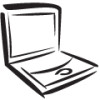Gateway M520 User Guide Gateway M520 Notebook - Page 138
Mapping a network drive, Opening files across the network, To map a network drive
 |
View all Gateway M520 manuals
Add to My Manuals
Save this manual to your list of manuals |
Page 138 highlights
4 Double-click the name of your workgroup. The names of each of the computers in your workgroup are listed. For more information about workgroups, see "Naming the computers and the workgroup" on page 111. 5 Double-click the name of the computer containing the drive or folder you want to view. All shared drives and folders are listed. Mapping a network drive After a drive or folder on one computer is mapped as a drive on another computer, the contents of the drive or folder can be accessed as if the drive were attached directly to the computer. For example, the My Documents folder on computer 1 is mapped as the Z drive on computer 2. To access the My Documents folder on computer 1 from computer 2, double-click the Z drive. To map a network drive: 1 Locate the drive or folder by completing the steps in "Viewing shared drives and folders" on page 131. 2 Right-click the drive or folder, then click Map Network Drive. The Map Network Drive wizard opens. 3 Click the arrow button to open the Drive list, then click the drive letter you want to map this drive or folder to. 4 Click Reconnect at Logon if you want to reconnect to this drive or folder each time you log on to the network. 5 Click Finish. Opening files across the network To open files across the network: 1 Start the program for the file you want to open. 2 Click File, then click Open. 132 www.gateway.com















